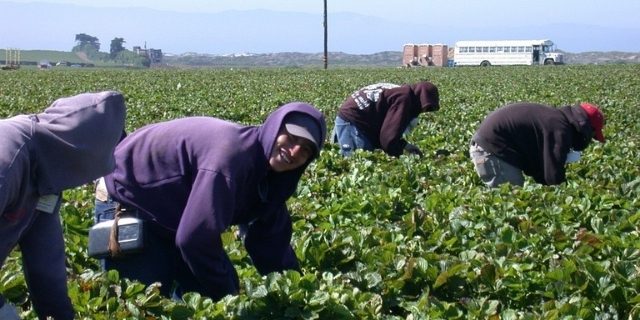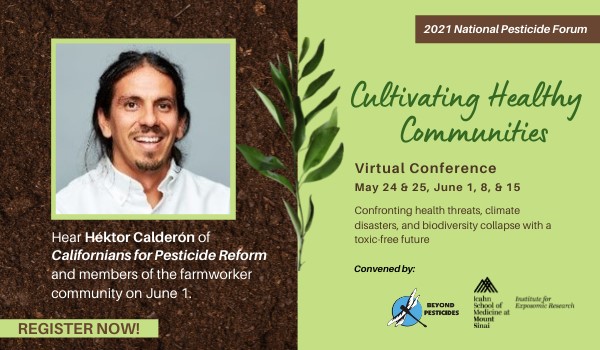01
Jun
Tell EPA to Protect Farmworkers Now; Hear Directly from Farmworker Community Members

(Beyond Pesticides, June 1, 2021) Farmworkers are at greatest risk from pesticides. EPA’s policies toward farmworkers comprise a blatant example of systemic racism. Although everyone suffers from pesticide poisoning, farmworkers and their families shoulder a disproportionate burden of the hazards.
Agricultural justice demands that we ensure a workplace with fair wages and benefits, no discrimination or coercion, and protection from hazards, such as harmful chemicals, including pesticides. Acknowledging, respecting, and sustaining the workers who plant, cultivate, and harvest our food is central to the basic values and principles that advance sustainable practices.
Agricultural justice demands that we ensure a workplace with fair wages and benefits, no discrimination or coercion, and protection from hazards, such as harmful chemicals, including pesticides. Acknowledging, respecting, and sustaining the workers who plant, cultivate, and harvest our food is central to the basic values and principles that advance sustainable practices.
Tell EPA to protect farmworkers from pesticides.
Worker Protection Standards Are Inadequate to Protect Farmworkers
Worker protection standards are set by the U.S. Environmental Protection Agency (EPA) under the Federal Insecticide Fungicide and Rodenticide Act (FIFRA). The original standard was developed after field hearings in which EPA heard from growers, but not farmworkers. With the threat of litigation from the National Association of Farmworker Organizations and Migrant Legal Action Program looming in the late 1970s, the Carter Administration funded an effort, conducted by Beyond Pesticides’ executive director, to reach out to workers and collect data on their experiences with pesticide exposure and poisoning in the fields.
Through a series of field hearings in collaboration with the nongovernmental organization Rural America, and EPA’s Office of Pesticide Programs, federal and state agencies heard directly from farmworkers. Although EPA concluded in 1983 that the regulations were inadequate to protect agricultural workers, it took until 1992 to update the Agricultural Worker Protection Standards (WPS).
Those 1992 updates to the WPS were intended to eliminate or reduce exposure to pesticides, mitigate exposures that occur, and inform employees about the hazards of pesticides. Despite these intentions, the updated WPS still did not adequately protect farmworkers. These standards have been notoriously difficult to enforce and require no record keeping documenting whether the rules have been implemented and only minimal training—all of which can threaten farmworkers and their families.
On September 28, 2015, EPA finally released its new regulation regarding farmworker pesticide safety, revising the WPS, which had not been updated for more than 20 years. These revisions attempt to strengthen the standards through increased training
for workers who handle pesticides, improved notification of pesticide applications, and a first-time minimum age requirement for children to work around pesticides. However, the Trump Administration weakened these standards, including reducing protection offered by Application Exclusion Zones (buffer zones).
Systemic Racism is Embodied in EPA’s Risk Assessments
Exposure assessments inevitably discount the impact workers, people of color, and those with preexisting health conditions or comorbidities. For example, EPA routinely calculates worker exposure separately from other exposures. In applying aggregate exposure assessments of pesticides, EPA does not include worker exposure. Risk assessments do not include exposures to multiple chemicals—and such exposures that routinely occur to fenceline communities, farmworkers, and factory workers.
In the past, EPA has admitted that even with maximum feasible personal protective equipment (PPE) and engineering controls, including all provisions required by the WPS, risks to workers still exceed EPA’s levels of concern. A 2008 study analyzing poisonings of pesticid
e workers between 1998 and 2005 concluded that in 30% of the cases of high levels of pesticide exposure, all labeling requirements, including those involving re-entry and PPE, had been followed — clearly demonstrating that the WPS and/or labeling requirements are inadequate.
Farm work is demanding and dangerous physical labor. As the scientific literature confirms, farmworkers, their families, and their communities face extraordinary risks from pesticide exposures. Pesticide application and drift result in dermal, inhalation, and oral exposures that are typically underestimated. A 2004 study detected agricultural pesticides in homes near to agricultural fields. According to a 2010 study, workers experience repeated exposures to the same pesticides, evidenced by multiple pesticides routinely detected in their bodies. As a result of cumulative long-term exposures, farmworkers and their children, who often also work on the farms, are at risk of developing serious chronic health problems such as cancer, neurological impairments, and Parkinson’s disease. Children, according to an American Academy of Pediatrics (AAP) report (2012), face even greater health risks compared to adults when exposed to pesticides. For more information, read our factsheet, Children and Pesticides Don’t Mix.
What We Can Do
Our food choices have a direct effect on those who, around the world, grow and harvest what we eat. This is why food labeled organic is the right choice. In addition to serious health questions linked to actual residues of toxic pesticides on the food we eat, our food buying decisions support or reject hazardous agricultural practices and the protection of farmworkers and farm families. See Beyond Pesticides’ guide to Eating with a Conscience to see how your food choices can protect farmworkers. In addition to choosing organic, it is important to consider food labels that create standards for farmworker safety and fairness. See below for more information and resources on how to uphold strong agricultural justice standards.
Tell EPA that we need strong Worker Protection Standards, and more fundamentally, EPA must base its pesticide risk assessments on the dangers to the most vulnerable people—farmworkers and their families. EPA must reverse its policy and require that risk assessments adopt a standard that protects farmworkers.
Beyond Pesticides is holding a virtual National Pesticide Forum, in which we address these issues.
Tell EPA to protect farmworkers from pesticides.

On Tuesday, June 1, our virtual Forum will address these issues in two sessions with farmworker community representatives address these issues in two sessions with farmworker community representatives. The Forum runs half days for the next three Tuesdays. Schedule won’t work for you? No worries, sessions will be available on demand for your viewing convenience. Register now.
Letter to the U.S. Environmental Protection Agency
Farmworkers are at greatest risk from pesticides. EPA’s policies toward farmworkers comprise a blatant example of systemic racism. Although suffer from pesticide poisoning, farmworkers and their families shoulder a disproportionate burden of the hazards.
Agricultural justice must ensure a workplace with fair wages and benefits, no discrimination or coercion, and protection from hazards, such as harmful chemicals, including pesticides. Acknowledging, respecting, and sustaining the workers who plant, cultivate, and harvest our food is central to the basic values and principles that advance sustainable practices.
Worker protection standards (WPS) are set by the U.S. Environmental Protection Agency (EPA) under the Federal Insecticide Fungicide and Rodenticide Act (FIFRA). The various iterations of the WPS have failed to adequately protect farmworkers. These standards have been notoriously difficult to enforce, and require no record keeping documenting whether the rules have been implemented and only minimal training—all of which can threaten farmworkers and their families. On September 28, 2015, EPA finally released its new regulation regarding farmworker pesticide safety, revising the WPS. These revisions attempt to strengthen the standards through increased training for workers who handle pesticides, improved notification of pesticide applications, and a first-time minimum age requirement for children to work around pesticides. However, the Trump Administration weakened these standards, including reducing protection offered by Application Exclusion Zones (buffer zones).
Systemic racism is embodied in EPA’s risk assessments. Exposure assessments inevitably discount the impact workers, people of color, and those with preexisting health conditions or comorbidities. For example, EPA routinely calculates worker exposure separately from other exposures. EPA has admitted that even with maximum feasible personal protective equipment (PPE) and engineering controls, including all provisions required by the WPS, risks to workers still exceed EPA’s levels of concern. In applying aggregate exposure assessments of pesticides, EPA does not include worker exposure. Risk assessments do not include exposures to multiple chemicals—and such exposures routinely occur to fenceline communities, farmworkers, and factory workers.
Please implement strong Worker Protection Standards and reverse the weakening changes of the Trump administration. More fundamentally, EPA must base its pesticide risk assessments on the dangers to the most vulnerable people—farmworkers and their families. EPA must reverse its policy and require that risk assessments adopt a standard that protects farmworkers.
Thank you.










